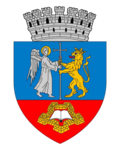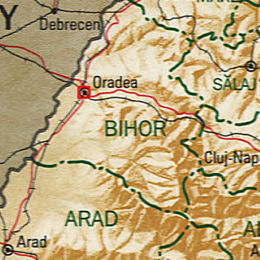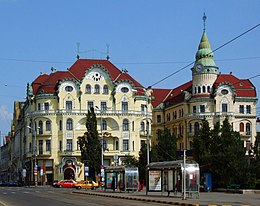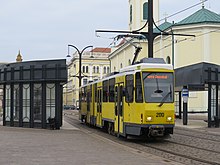Oradea
|
Oradea Oradea Nagyvárad Velky Varadin |
||||
|
||||
| Basic data | ||||
|---|---|---|---|---|
| State : |
|
|||
| Historical region : | Screeching area | |||
| Circle : | Bihor | |||
| Coordinates : | 47 ° 3 ' N , 21 ° 56' E | |||
| Time zone : | EET ( UTC +2) | |||
| Height : | 142 m | |||
| Area : | 115.56 km² | |||
| Residents : | 196,367 (October 20, 2011) | |||
| Population density : | 1,699 inhabitants per km² | |||
| Postal code : | 410100 | |||
| Telephone code : | (+40) 02 59 | |||
| License plate : | bra | |||
| Structure and administration (as of 2016) | ||||
| Community type : | Municipality | |||
| Structure : | 16 boroughs | |||
| Lord Mayor : | Ilie-Gavril Bolojan ( PNL ) | |||
| Postal address : | Piața Unirii, No. 1 loc. Oradea, Jud Bihor, RO-410100 |
|||
| Website : | ||||
Oradea ([ oˈrade̯a ], German : Großwardein , Hungarian : Nagyvárad , Slovak : Veľký Varadín , Latin : Magnovaradinum ) is a city in Romania and the capital of Bihor County .
geography
Oradea is located on the eastern edge of the Great Hungarian Plain on the River Crișul Repede (German Schnelle Kreisch , Hungarian Sebes-Körös ). The city center is 13 km from the Hungarian border. The foothills of the Apuseni Mountains end on the northeastern edge of the city . The area is thus a transition zone between hilly relief and plain.
The castle and thus also the city are strategically located at the opening of the Kreisch Valley into the Great Hungarian Plain at an average height of 126 m. The river flows almost centrally through the city. The train station is north of the Schnellen Kreisch, the castle on the south bank. Parts of the city are up to approx. 300 m above sea level on the Varadiens hills north of the main train station.
From a geological point of view, the caves, some of which reach below the city, are remarkable, the thermal springs of which have gained a certain fame in Băile Felix.
City structure
Oradea is divided into the districts Sub Cetate ( city center ), Rogerius, Ioșia, Ioșia Nord, Orașul Nou ( Neustadt ), Olosig ( Wallendorf ), Cantemir, Velența, Seleuș, Salca, Nufărul, Tokai, Eminescu, Episcopia Bihor, Ion Bogdan and Iorga.
climate
Mainly determined by westerly winds, the city has a temperate continental climate with an annual average temperature of 10.4 ° C. The mean average temperature in July does not exceed 21 ° C and in January is −1.4 ° C. The average annual precipitation is 585.4 mm, which is increased for a location in the plain and is explained by the location in front of the hilly areas in the east. The west and south-west slopes have been used for viticulture since Roman times .
history
Varadinum vulgo Groß-Wardein in an illustration from 1617
Gros Wardein (left center) around 1782 (recording sheet of the Josephinische Landesaufnahme )
Groszwardein (N 47 °; E 39 ° 35 ') around 1892 (recording sheet of the Franzisco-Josephinische Landesaufnahme )
The history of Varadinum begins with the establishment of a settlement Salca by the Romans . Ladislaus I of Hungary made the city a Roman Catholic bishopric in 1080 . The city is mentioned in a document in 1113 in a document from the Benedictine abbey of Zobor , in which a bishop Syxtus Varadiensis (Sixtus from Varad) is mentioned.
The city has belonged to the Kingdom of Hungary since its foundation . From the 11th to the 15th centuries, Oradea was the burial place for several members of the Hungarian royal family . The German Emperor Sigismund , who was also the Hungarian King from 1387 until his death in 1437, is also buried here. After Hungary disintegrated due to the defeat in the Battle of Mohács (1526) , the Habsburg Roman-German king and later Emperor Ferdinand I and the Transylvanian prince Johann Zápolya waged a war over the Hungarian territories that had not fallen to the Turks. On February 24, 1538, the peace of Great Oradin was concluded between the two of them . Oradea became part of the Habsburg Empire. In autumn 1598 the town was successfully defended against 100,000 Turks by a small garrison led by General Melchior von Redern , who came from Reichenberg , but was then captured in 1660 and left to the Turks in the Treaty of Eisenburg . It did not return to Austria until 1692.
When the Hungarian revolutionary government fled to Debrecen in the years 1848-49 , archives, banknote press etc. were brought to Oradea.
The city experienced a great economic boom, especially at the end of the 19th and beginning of the 20th century, not least thanks to its industrious, talented and relatively numerous Jewish population, who made up about a sixth of the then 100,000 inhabitants shortly before the Second World War . Even today, splendid, partly dilapidated Art Nouveau palaces bear witness to the glorious past.
After the Austro-Hungarian Compromise in 1867, Oradea was the seat of the Hungarian Bihar County and the junction of seven railway lines. Around 1900 the city had 17 churches and six monasteries, including two cathedrals, two episcopal palaces, canons' houses and many magnificent public and private buildings. A theater and town hall were rebuilt around 1890, and a St. Ladislaus monument was unveiled in 1892.
After the First World War , Hungary had to cede the Kreischgebiet and thus Oradea to the new Greater Romania in the Treaty of Trianon - despite its Hungarian majority at the time . This was primarily for strategic reasons; Romania should be brought into full possession of the Oradea – Satu Mare railway line . In 1940, Oradea reverted to Hungary through the Second Vienna Arbitration . As early as October 12, 1944, the city was captured by Romanian and Soviet troops and has since returned to Romanian territory.
population
The inhabitants were initially predominantly Hungarians ; however, the proportion of Romanian residents has increased steadily since the beginning of the 20th century; the city has had a Romanian majority since about 1970. The noticeable fluctuations in ethnicity listed in the table below are partly due to the political pressure of the respective country. Until 1910 the Jews were counted as Hungarians. In 1920 17,931 Jews lived in Oradea, their share was 25%. At the 2002 census there were 206,614 residents in the city, including 145,284 Romanians, 56,985 Hungarians , 2,449 Roma , 563 Germans , 474 Slovaks , 166 Jews and 109 Italians. In 2009 the city had 204,477 inhabitants.
| year | Residents | % Romanians | % Hungary |
|---|---|---|---|
| 1538 | 20,000 (estimated) | n / A | n / A |
| 1720 | 216 (Turks, Greeks, Serbs) | n / A | n / A |
| 1787 | 9790 | n / A | n / A |
| 1870 | 28,698 | n / A | n / A |
| 1880 | 34,231 | 4% | 87% |
| 1890 | 42,042 | 6% | 90% |
| 1900 | 54,109 | 6% | 90% |
| 1910 | 68,960 | 5% | 91% |
| 1920 | 73.025 | 12% | 62% |
| 1930 | 88,830 | 25% | 54% |
| 1941 | 98,621 | 5% | 92% |
| 1956 | 99,663 | 36% | 59% |
| 1966 | 122,534 | 46% | 51% |
| 1977 | 170,531 | 54% | 44% |
| 1992 | 222,741 | 65% | 33% |
| 2002 | 206.614 | 70% | 28% |
| 2009 | 204,477 | ||
| 2011 | 196.367 | 68% | 23% |
Religions
In 1890, 12,030 of the 42,000 inhabitants at that time were Roman Catholic, 10,880 Reformed and 10,115 Israelites. The distribution of the religions of today's residents is as follows:
- 50.0% Orthodox
- 25.0% Roman Catholics ; see Roman Catholic Church in Romania
- 16.1% Greek Catholics ; see special article Romanian Catholic Church
- 7.8% Protestants
- 1.1% others.
Oradea is the seat of the Roman Catholic diocese of Oradea Mare , a Greek Catholic diocese of Oradea and a district of the Evangelical Reformed Church.
There are nine evangelical reformed congregations in Oradea. Most of its members belong to the Hungarian minority. There is also an Evangelical Lutheran congregation. It has 750 members, including a few Germans.
There was also a Jewish community in the city for a long time. The first synagogue was built in 1803. The Jewish community was split into Orthodox and Neologic communities. The Jewish residents of Oradea were very active in public life. In 1902 there was even a Jewish police chief. In January 1941 the Hungarian census counted 21,333 Jews, that is 23 percent of the resident population. Most of the Jewish residents were killed in the Holocaust . Today there are hardly any Jews left in Oradea. However, the neological synagogue "Zion" on the river in the city center still dominates the cityscape.
coat of arms
The first remaining image of the city coat of arms comes from the city seal. It shows ( heraldically ) the bishop with the staff in the early and high Gothic triangular shield.
Culture and sights
Buildings
Several church buildings are worth seeing, including the Roman Catholic Cathedral of St. Mary of the Assumption from the 18th century, the largest baroque building in Romania , or the so-called "Moon Church", whose mechanical clock shows the phases of the moon, but also the remains of the star fortress and Art Nouveau palaces such as the Shopping arcade to the black eagle (Vulturul negru). In Oradea there is a state theater and a concert hall (State Philharmonic).
Mineral baths
The baths Băile 1 Mai (German Bishop's Bath , Hungarian Püspökfürdö ) and Băile Felix (German Felixbad , Hungarian Félixfürdő ) are located near the city . The latter has been connected to Oradea again by a railway line since 2010 - after a 10-year break. In the parks with alkaline sulfur springs, the rare thermal water lily thrives in their runoff . It is an endemic species. The newer district of Nufărul was named after the plant.
Music history
Johann Michael Haydn (1737–1806), the younger brother of Joseph Haydn (1732–1809), was from 1757 until his engagement as court composer and concertmaster of the Salzburg court orchestra in 1762/63 violinist and conductor of the Bishop of Großwardein, Adam Freiherr von Patácic (Patachich) by Zajezda . After his departure, the position remained vacant for two years until Karl Ditters von Dittersdorf (1739–1799), who came from Vienna, succeeded Michael Haydn in 1765 and increased the orchestra to 34 musicians. He added the clarinet to the orchestra, which had not been used up until then , and also followed the Viennese model by having the musicians play while seated. Dittersdorf stayed until 1769, when the orchestra was disbanded after the Empress Maria Theresa reprimanded Bishop Patácic for secular behavior during Lent.
Economy and Infrastructure
Around 1890 there were several distilleries (distilleries, six factories), three steam mills and a few brick factories in Oradea. Other residents lived from the manufacture of stoves, from cattle breeding, fruit and viticulture ( see: Viticulture in Romania ). At that time Oradea had its own water pipe, a large bath, a tram and numerous teaching and educational institutions (law academy, Premonstratensian high school, two theological seminars, a state midwifery school, six hospitals, etc.), an archaeological museum and an art museum, a Bihor mountain association. Furthermore, the city was then the seat of a court of law, a finance directorate, a post and telegraph directorate and a chamber of commerce and industry.
Today Oradea is a transport hub and economic center in Bihor County . The city is - seen from Central Europe - the gateway to Transylvania .
Textiles, shoes, food, glass, tools and agricultural machinery are produced. The Romanian power supply company Transelectra operates a switchgear near the city that connects the country to the European power grid via an overhead line to Hungary.
traffic
Rail transport
Oradea has been connected to the railway network since 1858 when the Püspökladány – Oradea railway went into operation . The city now has five passenger train stations, including two long-distance train stations (Central Station and Episcopia Bihor) and three exclusively for local trains (Oradea Est, Oradea Est Triaj and Oradea Vest).
Public transport
The transport includes a plurality of tram lines and buses and is represented by the OTL (Local Transport Oradea) managed. In the 1990s, the old Romanian tram cars were replaced by T4D from the German cities of Magdeburg and Dresden and KT4D from Berlin . Articulated trolleys of the ULF ( Ultra Low Floor , produced by Siemens in Vienna) have also been in operation since 2008 .
air traffic
The Oradea Airport (Aeroportul Internaţional Oradea) is currently in service of TAROM served and offers flights to Otopeni . (As of October 2019) . The concrete runway is 2100 meters long and 45 meters wide. In 2008 there were around 50,000 air travelers. In 2017, the number of passengers increased by 289.09% compared to 2016 to 162,902 air travelers.
Trunk roads
The European roads E 60 , E 79 and E 671 run through the city .
Universities and colleges
- Oradea University
- University of Emanuel Oradea
- University of Agora
- University of Partium
Sports
Oradea has developed into the country's water polo stronghold thanks to the Ioan Alexandrescu swimming pool, which opened in 2006 . The local club CSM Oradea also uses the proximity to Hungary, which is the record Olympic champion in this sport. International games also take place regularly in the hall, which with its 50-meter pool and a convertible roof is unique in the country and in 2008 also hosted the men's Olympic qualification tournament.
Personalities
Born in Oradea
- Péter Váradi (around 1450–1503), Archbishop of Kalocsa
- Péter Pázmány (1570–1637), Archbishop of Esztergom
- Sigismund Báthory (1572–1613), Prince of Transylvania
- Gabriel Báthory (1589–1613), Prince of Transylvania
- Ferenc Rhédey (1610–1667), Prince of Transylvania
- Mihály Teleki (1634–1690), Chancellor of Transylvania, died in a battle against Emmerich Thököly, sent by the Turks, near Zernyest ( Zernen ).
- Ödön Beöthy (1796–1854), Government Commissioner for Transylvania in 1848, Vice Spaniard of the Hungarian Bihar County
- Emanuil Gojdu (1802–1870), lawyer and Romanian patriot and freedom fighter for the rights of Romanians in Transylvania
- József Nagysándor (1804–1849), Hungarian army general, Arad martyr
- Ede Szigligeti (1814–1878), Hungarian playwright
- Antal Csengery (1822-1880), historian
- Johanna Dill-Malburg (1859–1944), painter
- Moritz Rosenthal (1832 / 1833–1889), Austrian neurologist
- Pál (Paul) Böhm (1839–1905), painter
- Dezső Szilágyi (1840–1901), lawyer, Minister of Justice
- Baron Arthur von Hübl (1853–1932), Austrian Lieutenant Field Marshal, chemist and cartographer
- Gusti (Augustine) Zimmermann (1865–1906?), Actress and composer
- Diósy Ödönné Adél Brüll (1872–1934), Muse of Endre Ady
- Károly Bakonyi (1873–1926), writer
- Ernő Osvát (1876–1929), founder of Nyugat magazine
- Jenő Pozsonyi (1885–1936), Transylvanian painter who was close to naturalism and impressionism
- Erzsébet (Elisabeth) Radó – Révész (1887–1923), Transylvanian neurologist, psychoanalyst and member of the Vienna Psychoanalytic Association .
- Friedrich Schorr (1888–1953), Hungarian-Jewish bass baritone
- Emil Telmányi (1892–1988), violinist and conductor
- Paul Gyorgy (1893–1976), Transylvanian pediatrician and nutritionist
- Ernő Erbstein (1898–1949), Hungarian football player and coach
- Zsigmond Széchenyi (1898–1967), traveler to Africa
- Iosif Bartha (1902–1957), football player
- Albert Ströck (1902–1971), football player
- Béla Grunberger (1903-2005), French psychoanalyst
- Georges Politzer (1903–1942), French philosopher and Marxist theorist
- Lajos Steiner (1903–1975), Hungarian-Australian chess player
- Boris Palotai (1904-1983), a writer with the Attila József Prize awarded
- Imre Ványai (1904–1980), painter and graphic artist
- Endre Kabos (1906–1944), Hungarian saber fencer and resistance fighter
- Margit Dajka (Dayka) (1907-1986), an actress with the Kossuth Prize awarded
- Ernő Grünbaum (1908–1944 or 1945), Transylvanian expressionist painter
- László Halmos (1909–1997), Hungarian composer
- Szabolcs Fényes (1912–1986), composer, was awarded the Erkel Prize
- Brúnó Straub (1914–1996), academic, head of state of Hungary 1988–1989
- Ferenc Berko (1916–2000), Hungarian-American photographer
- Francisc Spielmann (1916–1974), Romanian-Hungarian football player
- Stephanus Dászkál (1919–2003), Ordinarius ad nutum Sanctae Sedis
- Nándor Wagner (1922–1997), sculptor
- Carol Bartha (1923–1976), football player
- Anton Fernbach (* 1925), football player
- Gavril Serfőző (born 1926), football player
- Gheorghe Băcuț (1927–1974), football player
- Mircea Malița (* 1927), mathematician, essayist, diplomat, minister of education, university professor
- Tiberiu Bone (1929–1983), football player
- István Erdélyi (1931–2020), archaeologist and historian
- Éva Heyman (1931–1944), diary writer and Holocaust victim
- József Bartovics (1935–2005), painter
- Júlia Várady (* 1941), Hungarian-German opera singer
- Mihai Bărbulescu (* 1947), ancient historian and classical archaeologist
- Attila Kun (* 1949), German-Romanian soccer player
- Șerban-Dan Costa (* 1955), physician, university professor at Otto von Guericke University Magdeburg
- Zoltan Crișan (1955-2003), football player
- Olga Anna Duhl (* 1956), literary scholar, university professor at Lafayette College (Easton, PA)
- Asteris Koutoulas (* 1960), German-Greek music producer, publicist, translator and author
- Daniel Lascău (* 1969) German judoka
- Erik Lincar (* 1978), football player
- Csilla Ababi (1983-2019), actress
- Mihai Neșu (born 1983), football player
- Ioan Hora (* 1988), football player
Died in Oradea
- Florian Römer (1817–1889), canon and Hungarian ancient historian
- Lőrinc hose (1824–1902), cardinal
- Iosif Vulcan (1841–1907), academic, publicist and writer
- Jenő Pozsonyi (1885–1936), Transylvanian painter who was close to naturalism and impressionism
- Miklós Nyiszli (1901–1956), Romanian, Hungarian-speaking medical doctor of Jewish descent and Holocaust survivor
- Alfred Macalik (1888–1979), Austrian-Romanian landscape painter, graphic artist, sculptor and composer
- László Hosszú (1913–1983), vicar general of the Oradea Mare diocese
- József Bartovics (1935–2005), painter
Town twinning
Oradea lists the following five twin cities :
| city | country | since |
|---|---|---|
|
Ceyrat |
|
2008 |
|
Coslada |
|
2005 |
|
Debrecen |
|
1992 |
|
Giv'atajim |
|
2005 |
|
Mantua |
|
2005 |
See also
literature
- Robotos Imre: A vér városa, Nagyvárad. Művelődéstörténeti tükör. Csokonai, Debrecen 1992, ISBN 963-260-045-2 .
- Nagyvárad , in: Guy Miron (Ed.): The Yad Vashem encyclopedia of the ghettos during the Holocaust . Jerusalem: Yad Vashem, 2009 ISBN 978-965-308-345-5 , pp. 516ff.
Web links
- Official website of the city of Oradea
- Virtual walk (requires Flash)
- Tram in Oradea
Individual evidence
- ↑ 2011 census in Romania ( MS Excel ; 1.3 MB)
- ↑ Mayoral elections 2016 in Romania ( MS Excel ; 256 kB)
- ↑ Tanja Michalsky : Memoria and Representation. The tombs of the Anjou royal family in Italy (= publications of the Max Planck Institute for History. Vol. 157). Vandenhoeck & Ruprecht, Göttingen 2000, ISBN 3-525-35473-8 , p. 361.
- ^ Hungarian Economic Yearbook. Vol. 1, 1935, ZDB -ID 566194-8 , p. 387.
- ↑ Censuses in Transylvania 1850–2002 (Hungarian), accessed on August 15, 2009 (PDF; 1.1 MB)
- ↑ 2002 census (Hungarian), accessed on August 15, 2009
- ↑ citypopulation.de , Romania, as of January 2009
- ^ Historical map as a digitized version of the University and State Library Düsseldorf
- ↑ Flight program on the airport website accessed on October 8, 2019 (Romanian)
- ↑ Oradea Airport website: Significant increase in passenger numbers. January 3, 2018, archived from the original on May 13, 2018 ; Retrieved May 12, 2018 (Romanian).
- ↑ a b c d e f g h i Information in the Hungarian Biography Lexicon 1900–1990 at mek.oszk.hu accessed on August 31, 2014 (Hungarian)
- ↑ Pósta Béla, Kelemen Lajos Jr., Biás István: Bestattung Mihály Teleki , Koloszvár, 1913. Retrieved from mek.oszk.hu on August 31, 2014 (Hungarian; PDF)
- ↑ Information on Beőthy Ödön at mek.oszk.hu accessed on August 31, 2014 (Hungarian)
- ↑ Cătălin Fudulu: Declassified documents / amazing fate of the Aromanian Gojdu , on November 11, 2009 from zf.ro/Ziarul de duminică accessed on August 30, 2014 (Romanian)
- ↑ Information on József Nagysándor at nefmi.gov.hu accessed on August 31, 2014 (Hungarian; PDF)
- ^ Wilhelm Kosch: Deutsches Theater-Lexikon , Gusti (Augustine) Zimmermann, online p. 3807 at Google Books
- ↑ Information on Ernő Osvát from oszk.hu accessed on August 30, 2014 (Hungarian)
- ↑ In memory of Wagner Nándor , accessed on August 31, 2014.
- ↑ Information on Malița (Augustin) Mircea, from members of the Central Committee of the Romanian Communist Party 1945–1989 , from the National Council for the Review of the Securitate Archive, p. 371, accessed on August 30, 2014 (Romanian; PDF)
- ↑ Information on Iosif Vulcan at istoria.md accessed on August 31, 2014 (Romanian)
- ↑ Information on Hosszú László from lexikon.katolikus.hu accessed on August 31, 2014 (Hungarian)
- ↑ Oraşe înfrăţite. Retrieved November 11, 2017 .










